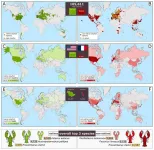Scientists discover unexpected link between genes involved in human brain evolution and developmental disorders
Human-specific genes regulate key gene mutated in autism spectrum disorders
2024-10-14
(Press-News.org)
Leuven, 14 October 2024 - The human brain’s remarkably prolonged development is unique among mammals and is thought to contribute to our advanced learning abilities. Disruptions in this process may explain certain neurodevelopmental diseases. Now, a team of researchers led by Prof. Pierre Vanderhaeghen (VIB-KU Leuven), together with scientists of Columbia University and Ecole Normale Supérieure has discovered a link between two genes, present only in human DNA, and a key gene called SYNGAP1, which is mutated in intellectual disability and autism spectrum disorders. Their study, published in Neuron, provides a surprisingly direct link between human brain evolution and neurodevelopmental disorders.
The human brain stands out among mammals for its remarkably prolonged development. Synapses – critical connections between neurons of the cerebral cortex, the brain’s main hub for cognition – take years to mature in humans, compared to just months in species like macaques or mice. This extended development, also known as neoteny, is thought to be central to humans' advanced cognitive and learning abilities. On the other hand, it has been hypothesized that disruptions of brain neoteny could be linked to neurodevelopmental disorders such as intellectual disability and autism spectrum disorder.
The lab of Pierre Vanderhaeghen at the VIB-KU Leuven Center for Brain & Disease Research previously discovered that the prolonged development of the human cerebral cortex is mainly due to human-specific molecular mechanisms in neurons. Now, they are investigating these molecular timers in human neurons.
Unlocking the secrets to slow synapse development
In their latest study, the team tested the involvement of two genes, SRGAP2B and SRGAP2C, which are unique to humans. First identified by Cécile Charrier in the laboratory of Prof. Franck Polleux (Columbia University, USA), these genes have been found to slow down synapse development when artificially introduced into mouse neurons of the cerebral cortex. The question if these genes function the same way in human neurons has remained unanswered.
To address this, Dr. Baptiste Libé-Philippot, a Postdoctoral Fellow in the Vanderhaeghen lab, switched off SRGA2B and SRGAP2C in human neurons, transplanted them into mouse brains, and carefully monitored synapse development over an 18-month period.
“We discovered that when you turn off these genes in human neurons, synaptic development speeds up at remarkable levels," says Dr. Libé-Philippot. "By 18 months, the synapses are comparable to what we would expect to see in children between five and ten years old! This mirrors the accelerated synapse development observed in certain forms of autism spectrum disorder.”
Clues to human-specific brain disorder susceptibility
The team then investigated the underlying genetic mechanisms behind the pronounced effects of SRGAP2B and SRGAP2C on human neuron neoteny. They focused on the SYNGAP1 gene, an important disease gene known to be involved in intellectual disability and autism spectrum disorder.
Remarkably, they discovered that the SRGAP2 and SYNGAP1 genes act together to control the speed of human synapse development. Most strikingly, they found that SRGAP2B and SRGAP2C increase the levels of the SYNGAP1 gene and can even reverse some defects in neurons lacking SYNGAP1. This finding increases our understanding of how human-specific molecules influence neurodevelopmental disease pathways, shedding light on why such disorders are more prevalent in our species.
Prof. Pierre Vanderhaeghen is looking forward to the future: “This work gives us a clearer picture of the molecular mechanisms that shape the slow development of human synapses. It is amazing to find out that the same genes that are involved in the evolution of the human brain also have the potential to modify the expression of specific brain diseases. This could have important clinical relevance: more research is needed to understand how human-specific mechanisms of brain development affect learning and other behaviors and how their dysregulation can lead to brain disorders. It becomes conceivable that some human-specific gene products could become innovative drug targets.”
—
Publication and funding
Human cortical neuron neoteny requires species-specific balancing of SRGAP2-SYNGAP1 cross-inhibition at the synapse. Libé-Philippot, et al. Neuron, 2024. DOI: 10.1016/j.neuron.2024.08.021
This work was performed in collaboration with VIB, KU Leuven, Columbia University (NY, US), and Ecole Normale Supérieure (Paris, France). It was supported by the European Research Council, the C1 KU Leuven Internal Funds Programme, the EOS Programme, ERA-NET NEURON, Research Foundation Flanders (FWO), the EU network NSC-Reconstruct, the Generet Foundation, the National Institutes of Health (NIH), the NOMIs Foundation, and the Belgian Queen Elizabeth Foundation.
END
[Attachments] See images for this press release:

ELSE PRESS RELEASES FROM THIS DATE:
2024-10-14
The future of wireless technology — from charging devices to boosting communication signals — relies on the antennas that transmit electromagnetic waves becoming increasingly versatile, durable and easy to manufacture. Researchers at Drexel University and the University of British Columbia believe kirigami, the ancient Japanese art of cutting and folding paper to create intricate three-dimensional designs, could provide a model for manufacturing the next generation of antennas.
Recently published in the journal Nature Communications, research from the Drexel-UBC team showed how kirigami — a variation of origami — ...
2024-10-14
Researchers from Peking University have conducted a comprehensive systematic review on the integration of machine learning into statistical methods for disease risk prediction models, shedding light on the potential of such integrated models in clinical diagnosis and screening practices. The study, led by Professor Feng Sun from the Department of Epidemiology and Biostatistics, School of Public Health, Peking University, has been published in Health Data Science.
Disease risk prediction is crucial for early diagnosis and effective clinical decision-making. However, traditional statistical models, such as logistic regression and Cox proportional hazards regression, often ...
2024-10-14
Some people believe that talking to your plants makes them thrive. While there’s limited scientific support for sound improving plant health, there’s a growing amount of evidence about the benefits of mechanical stimulation, like touch, wind or rain. Researchers reporting in ACS’ Journal of Agricultural and Food Chemistry examined the impact of watering practices on tomato plants. They found that the size of the water droplets affected plant growth and resistance to pests and pathogens.
Climate change threatens crop production as rising ...
2024-10-14
Preeclampsia is a life-threatening pregnancy complication marked by persistent high blood pressure that is even more serious when it occurs early in the first trimester. The exact cause of early-onset preeclampsia is unknown, and it is difficult to predict, prevent and diagnose. Now, in ACS’ Journal of Proteome Research, researchers report on six proteins that could be used as targets to diagnose and treat the condition.
Preeclampsia’s key symptom is high maternal blood pressure, and serious cases can lead to maternal organ failure, low infant birth weight, or maternal or fetal death. ...
2024-10-14
Artificial intelligence can help people process and comprehend large amounts of data with precision, but the modern image recognition platforms and computer vision models that are built into AI frequently overlook an important back-end feature called the alpha channel, which controls the transparency of images, according to a new study.
Researchers at The University of Texas at San Antonio (UTSA) developed a proprietary attack called AlphaDog to study how hackers can exploit this oversight. Their findings are described in a paper written by Guenevere Chen, an assistant professor in the UTSA Department of Electrical and Computer Engineering, and her former ...
2024-10-14
Freshwater crayfish, keystone species of aquatic ecosystems, are now at the center of a new tool that promises to revolutionize conservation efforts. World of Crayfish™ (WoC), a newly launched web platform, aims to provide real-time global mapping of freshwater crayfish and their pathogens, offering an invaluable resource for researchers, conservationists, and environmental stakeholders.
Published in PeerJ Life and Environment, the article, World of Crayfish™: A web platform towards real-time global mapping of freshwater crayfish and their pathogens, highlights the urgent need for accurate, up-to-date data on ...
2024-10-14
Biodiversity is in crisis. Human activities are driving species extinctions at unprecedented rates, but funding for conservation remains woefully inadequate. To address this gap, the concept of a Biodiversity Credit Market (BCM) has emerged, inspired by carbon credit systems that incentivize conservation and restoration efforts.
However, while the BCM holds promise, it risks falling into the same pitfalls as its carbon counterpart—especially if it fails to implement rigorous science-backed baselines, ...
2024-10-14
DAEJEON, South Korea (October 14, 2024) – Qunova Computing, a developer of quantum software applications designed to bring quantum computing to the chemical, pharmaceutical and industrial engineering industries, today announces the results from a series of recent tests performed on three different NISQ era quantum computers, each with a different qubit count. In each demonstration, Qunova’s algorithm was able to produce results with accuracy below the threshold of 1.6 millihartrees required for real-world quantum chemistry applications, a level known as ‘chemical ...
2024-10-14
Scientists have successfully bred corals to improve their heat tolerance
A new study has shown that selective breeding can lead to a modest rise in coral heat tolerance.
Led by experts at Newcastle University’s Coralassist Lab, the study documents the world’s first effort to selectively breed adult corals for enhanced heat tolerance, i.e. the ability of adult corals to survive intense marine heatwaves. The breeding effort was a success, showing that it is possible to improve the heat tolerance of adult coral offspring, even in a single generation.
However, the improvement was modest in comparison ...
2024-10-14
Seven of the most common forest trees in Europe have been shown to be able to shelter their genetic diversity from major shifts in environmental conditions. This is despite their ranges having shrunk and the number of trees having fallen sharply during ice age cycles. These are the findings of a study by a European consortium including Uppsala University, published in Nature Communications.
“From a biodiversity perspective, this is very positive because these trees are keystone species on which many other species depend,” says Pascal Milesi, Associate Professor of Plant Ecology and Evolution at Uppsala University and first author of the study.
The researchers aimed to investigate ...
LAST 30 PRESS RELEASES:
[Press-News.org] Scientists discover unexpected link between genes involved in human brain evolution and developmental disorders
Human-specific genes regulate key gene mutated in autism spectrum disorders







